Since its founding in 1987, OSC has remained on the forefront of technology by continually upgrading and launching new high performance computing resources while expanding its services to an array of academic disciplines and industries. As Ohio focuses on heightening its scientific capabilities and workforce development strategies to ensure its economic success, OSC is becoming an even more critical state resource.
“It’s our job to constantly be on the cutting edge of technology, evaluating and deploying it, and making it available here in Ohio,” said Dave Hudak, executive director of OSC. “Beyond simply providing the technology, though, we also make it uniquely flexible, affordable and easy to access thanks to 35 years of experience pushing Ohio’s capabilities forward.”
The Launch of a State Supercomputer Center
OSC got its start when a group of faculty members at The Ohio State University responded to a U.S. National Science Foundation call for proposals for a high performance computing center. After the federal agency selected other proposals, the State of Ohio stepped in to establish the program as a statewide resource.
Under the umbrella of the Ohio Department of Higher Education (ODHE), OSC works with public and private institutions across the state and provides access to its high performance computing resources and services to faculty and students in a growing number of academic disciplines. Client organizations include 55 higher education institutions in Ohio and 200 other educational institutions such as K-12 districts and colleges outside of Ohio.
Faculty at higher education institutions use OSC to conduct original research in fields ranging from engineering and medicine to plant biology and political science. Ohio State researchers draw on OSC’s vast computing power to sequence DNA data that can help them understand how to grow more disease-resistant agricultural crops. A professor at the University of Toledo has used the Center’s resources to develop a risk assessment protocol for anterior cruciate ligament (ACL) injuries.
Being affiliated with the state rather than any single academic institution allows OSC to go beyond academia and provide its services to private industry – something many of its peers are not able to do.
“We work with companies all over the country and the world because it raises the image of Ohio, nationally and globally,” said Alan Chalker, OSC director of strategic programs. “It shows Ohio is a leader in innovation and is a great place to do business.”
Companies that use OSC include TotalSim, a computational fluid dynamics consulting and solutions firm that recently worked with the state of California on a project designed to reduce greenhouse gas emissions from tractor-trailers. The Center for Reliable Energy Systems also has used OSC resources to analyze how corrosion can impact the safety of U.S. pipelines. These are just two examples of the many industrial engagements OSC has cultivated over its 35-year history.
Advancement in Technological Capabilities
Over the years, OSC has continued to increase the power of its supercomputers and create larger storage systems and faster networks, said Doug Johnson, OSC associate director.
“We started out with these very exotic things called supercomputers that had a very specific definition back in the late 1970s and the early 1980s,” Johnson said. “It usually meant a computer from Cray or one of the other ‘big iron vendors.’ These were systems built for computational science and engineering and the characteristic needs of those applications versus mainframe-type computers that were used for accounting and other business purposes.”
Since those early days, OSC has regularly upgraded its supercomputing resources every couple of years to match the pace of technology innovations and client needs. Its two current supercomputer clusters are Owens, installed in 2016, and Pitzer, installed in 2018 with additions in 2020, which have combined capabilities of 5.5 petaflops.
In the past few years, OSC has evolved to support artificial intelligence (AI) and machine learning (ML), Johnson said. This allows for insights to be pulled from data in a simulation setting rather than use a system of partial differential equations to solve for information.
“Instead of doing a simulation of a car crash, researchers will take a bunch of data from either earlier simulations of car crashes or actual car crashes and feed it into these AI and ML models,” Johnson said. “The artificial intelligence programs will describe how your new design would behave without actually simulating a car crash using those underpinning equations and constraints to simulate the system. It just pulls inferences out of the old data and tells you how your new thing is going to perform.”
Ascend, a new Dell Technologies-based high performance computing cluster, will advance OSC’s ability to support AI, machine learning, big data and data analytics through its advanced NVIDIA graphics processing units (GPUs) in fall 2022.
The cluster will help meet the needs of an increasing number of clients involved with AI and machine learning fields. It will also aid OSC’s involvement in the AI Institute for Intelligent Cyberinfrastructure with Computational Learning in the Environment (ICICLE), a National Science Foundation-funded project designed to advance AI work led by The Ohio State University.
All of the clusters are available through OnDemand, OSC’s flagship instance of its NSF-funded open source Open OnDemand portal, which allows clients, computational researchers and students to easily access remote computing resources from any device. It also simplifies the user interface and experience, which helps OSC staff support a wide range of clients. Open OnDemand is used by more than 200 organizations around the world such as universities, medical schools, laboratories and supercomputer centers.
Workforce Development
Undergraduate and graduate students in a variety of disciplines — engineering and technology, natural sciences and medical and health sciences, as well as an increasing number from the social sciences — learn about high performance computing by participating in faculty research that uses OSC resources or through academic courses and teaching clinics.
Examples include professors at the University of Dayton who use OSC in the classroom to illustrate lessons about parallel computing concepts, as well as a faculty member at Kent State University who draws on the Center's advanced computing power to help students render models for an architectural design course.
“Part of our job is to not just provide these resources but help ensure that Ohio businesses and universities have a future workforce that can make use of these resources,” Chalker said.
Resources such as Open OnDemand are important in providing students access to virtual labs, especially during the COVID-19 pandemic. In the 2022 fiscal year, more than 3,492 students from 23 Ohio universities used supercomputing resources in 127 courses.
OSC also engages in outreach activities and programming for students in middle school and high school to help foster interest in STEM education and careers. The Center hosts the annual Summer Institute and Young Women's Summer Institute to provide hands-on scientific and advanced computing experiences to Ohio teens. OSC also regularly presents its "What's So Super about Supercomputing?" talk to various audiences throughout the year to demystify the subject.
“OSC has allowed thousands of students in the State of Ohio to gain high performance computing skills, both in classrooms and in research labs,” said Charles See, vice chancellor of strategic partnerships and educational technology at the Ohio Department of Higher Education. “The Center is a terrific resource for students seeking to advance their education and prepare for cutting-edge technology and research careers.”
Looking Forward
The Center’s vision is “to be a catalyst to position Ohio’s higher educational institutions and companies as world leaders with computationally enabled workforce and research endeavors.”
Johnson said his hope for the future of OSC is that the Center sees more disciplines realizing they need supercomputers for their research and that OSC can be a meaningful resource for researchers and other clients’ ever-expanding needs.
As the leading statewide resource for computational technologies, OSC also sees itself playing a role in developing a technology-enabled workforce that will be critical for projects such as Intel’s construction of one of the world’s largest microchip manufacturing complexes in Licking County, Ohio, which is expected to employ 3,000 workers. Since OSC’s founding the Center has collaborated frequently with Intel, and has incorporated its processors in 13 supercomputer clusters – including the Owens and Pitzer clusters.
“The Ohio Department of Higher Education is working with colleges and universities to ensure that students can access education and training that will prepare them for technology-focused career opportunities at employers such as the forthcoming Intel microchip manufacturing complexes,” said Randy Gardner, chancellor of the Ohio Department of Higher Education. “OSC plays an important role in supporting the state’s STEM pipeline and these workforce development initiatives.”
By Mary Kidwell
Photos
-
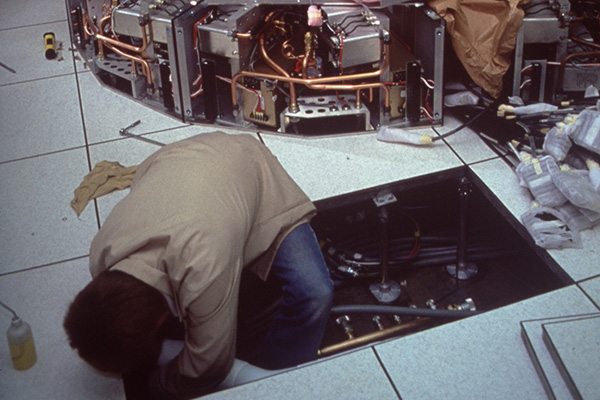
Individual installating the first supercomputer at OSC in 1987.
-

Individual pointing at a poster in the BALE Lobby during 2016 SUG.
-
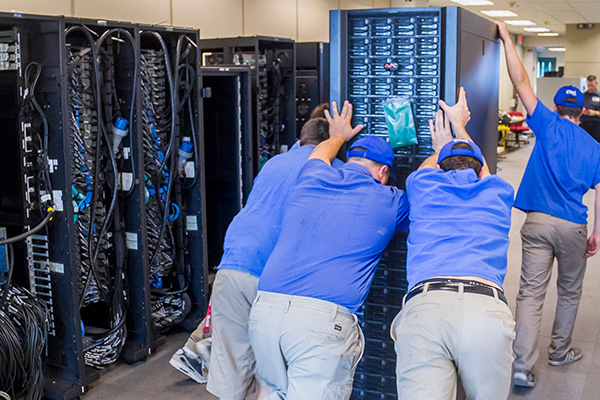
Group of individuals pushing a supercomputer rack during 2016 Owens cluster installation.
-
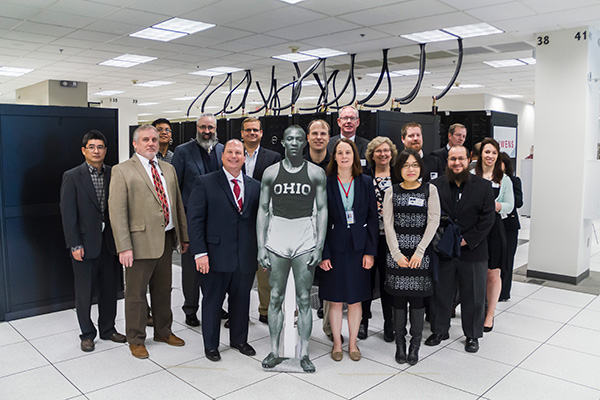
OSC team celebrates the installation of the Owens supercomputing cluster at the State of Ohio Computer Center (SOCC).
-
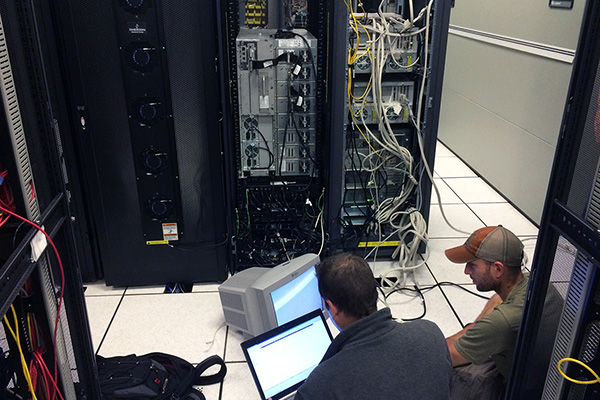
Two engineers working on a supercomputer rack at the SOCC.
-
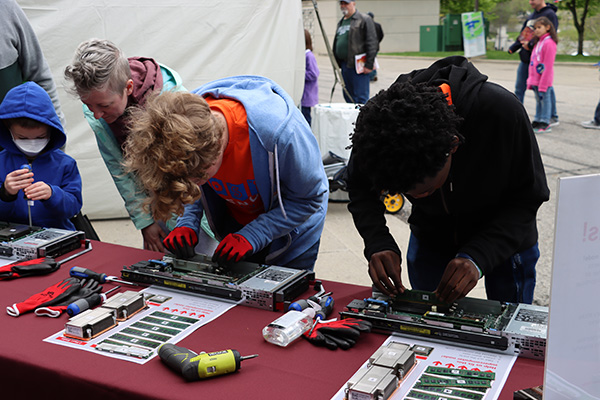
Children learning through an OSC interactive supercomputer node activity at 2022 COSI Big Science Day.
-
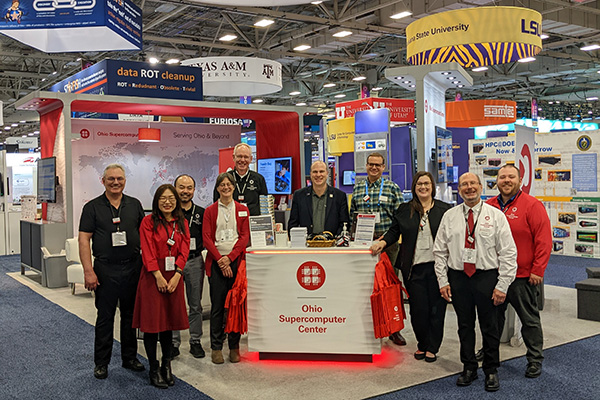
Team photo at the SC22 OSC and Open OnDemand booth.
-

Kirk Herath, Cybersecurity Strategic Advisor to Governor DeWine, touring the SOCC.
-
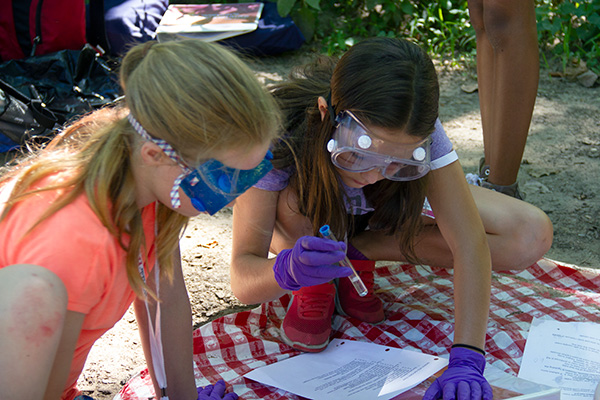
Students of 2018 Young Women's Institute testing for water quality at Batelle Darby Metro Park.
About OSC: The Ohio Supercomputer Center (OSC) addresses the rising computational demands of academic and industrial research communities by providing a robust shared infrastructure and proven expertise in advanced modeling, simulation and analysis. OSC empowers scientists with the services essential to making extraordinary discoveries and innovations, partners with businesses and industry to leverage computational science as a competitive force in the global knowledge economy and leads efforts to equip the workforce with the key technology skills required for 21st century jobs.